Related Research Articles

Image compression is a type of data compression applied to digital images, to reduce their cost for storage or transmission. Algorithms may take advantage of visual perception and the statistical properties of image data to provide superior results compared with generic data compression methods which are used for other digital data.
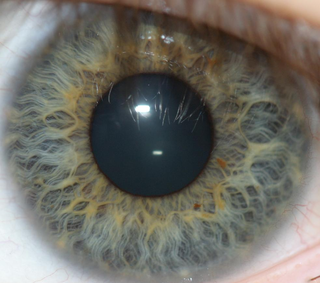
Iris recognition is an automated method of biometric identification that uses mathematical pattern-recognition techniques on video images of one or both of the irises of an individual's eyes, whose complex patterns are unique, stable, and can be seen from some distance. The discriminating powers of all biometric technologies depend on the amount of entropy they are able to encode and use in matching. Iris recognition is exceptional in this regard, enabling the avoidance of "collisions" even in cross-comparisons across massive populations. Its major limitation is that image acquisition from distances greater than a meter or two, or without cooperation, can be very difficult. However, the technology is in development and iris recognition can be accomplished from even up to 10 meters away or in a live camera feed.
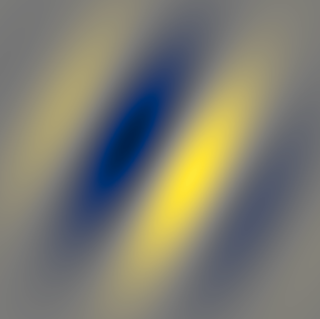
In image processing, a Gabor filter, named after Dennis Gabor, who first proposed it as a 1D filter. The Gabor filter was first generalized to 2D by Gösta Granlund, by adding a reference direction. The Gabor filter is a linear filter used for texture analysis, which essentially means that it analyzes whether there is any specific frequency content in the image in specific directions in a localized region around the point or region of analysis. Frequency and orientation representations of Gabor filters are claimed by many contemporary vision scientists to be similar to those of the human visual system. They have been found to be particularly appropriate for texture representation and discrimination. In the spatial domain, a 2D Gabor filter is a Gaussian kernel function modulated by a sinusoidal plane wave.

Thomas Shi-Tao Huang was a Chinese-born American computer scientist, electrical engineer, and writer. He was a researcher and professor emeritus at the University of Illinois at Urbana-Champaign (UIUC). Huang was one of the leading figures in computer vision, pattern recognition and human computer interaction.
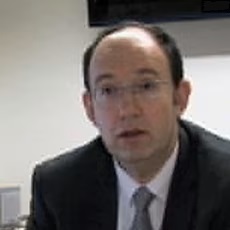
Sir Anthony Charles Wiener Finkelstein is a British engineer and computer scientist. He is the President of City, University of London. He was Chief Scientific Adviser for National Security to HM Government until 2021.
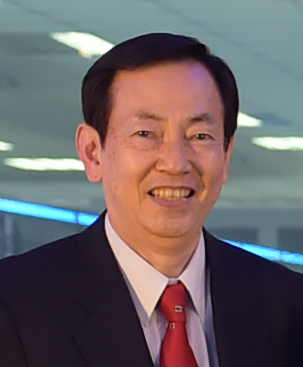
Yasuo Matsuyama is a Japanese researcher in machine learning and human-aware information processing.
Matti Kalevi Pietikäinen is a computer scientist. He is currently Professor (emer.) in the Center for Machine Vision and Signal Analysis, University of Oulu, Finland. His research interests are in texture-based computer vision, face analysis, affective computing, biometrics, and vision-based perceptual interfaces. He was Director of the Center for Machine Vision Research, and Scientific Director of Infotech Oulu.
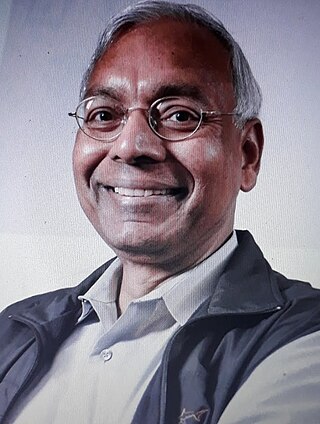
Anil Kumar Jain is an Indian-American computer scientist and University Distinguished Professor in the Department of Computer Science & Engineering at Michigan State University, known for his contributions in the fields of pattern recognition, computer vision and biometric recognition. He is among the top few most highly cited researchers in computer science and has received various high honors and recognitions from institutions such as ACM, IEEE, AAAS, IAPR, SPIE, the U.S. National Academy of Engineering, the Indian National Academy of Engineering and the Chinese Academy of Sciences.
Gabor wavelets are wavelets invented by Dennis Gabor using complex functions constructed to serve as a basis for Fourier transforms in information theory applications. They are very similar to Morlet wavelets. They are also closely related to Gabor filters. The important property of the wavelet is that it minimizes the product of its standard deviations in the time and frequency domain. Put another way, the uncertainty in information carried by this wavelet is minimized. However they have the downside of being non-orthogonal, so efficient decomposition into the basis is difficult. Since their inception, various applications have appeared, from image processing to analyzing neurons in the human visual system.
In signal processing it is useful to simultaneously analyze the space and frequency characteristics of a signal. While the Fourier transform gives the frequency information of the signal, it is not localized. This means that we cannot determine which part of a signal produced a particular frequency. It is possible to use a short time Fourier transform for this purpose, however the short time Fourier transform limits the basis functions to be sinusoidal. To provide a more flexible space-frequency signal decomposition several filters have been proposed. The Log-Gabor filter is one such filter that is an improvement upon the original Gabor filter. The advantage of this filter over the many alternatives is that it better fits the statistics of natural images compared with Gabor filters and other wavelet filters.
Josef KittlerFREng is a British scientist and Distinguished Professor at University of Surrey, specialising in pattern recognition and machine intelligence.

Sir John Michael Brady is an emeritus professor of oncological imaging at the University of Oxford. He has been a Fellow of Keble College, Oxford, since 1985 and was elected a foreign associate member of the French Academy of Sciences in 2015. He was formerly BP Professor of Information Engineering at Oxford from 1985 to 2010 and a senior research scientist in the MIT Computer Science and Artificial Intelligence Laboratory (CSAIL) in Cambridge, Massachusetts, from 1980 to 1985.

Theodosios Pavlidis is a computer scientist and Distinguished Professor Emeritus of Computer Science at the State University of New York, Stony Brook.

René Vidal is a Chilean electrical engineer and computer scientist who is known for his research in machine learning, computer vision, medical image computing, robotics, and control theory. He is the Herschel L. Seder Professor of the Johns Hopkins Department of Biomedical Engineering, and the founding director of the Mathematical Institute for Data Science (MINDS).
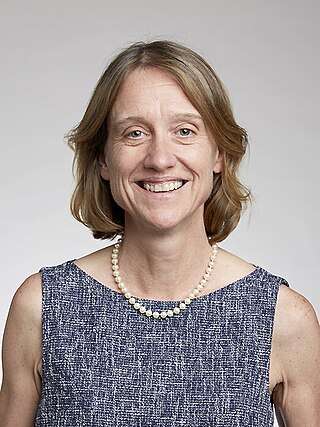
Julia Alison Noble is a British engineer. She has been Technikos Professor of Biomedical Engineering at the University of Oxford and a fellow of St Hilda's College since 2011, and Associate Head of the Mathematical, Physical and Life Sciences Division at the university. As of 2017, she is the chief technology officer of Intelligent Ultrasound Limited, an Oxford spin-off in medical imaging that she cofounded. She was director of the Oxford Institute of Biomedical Engineering (IBME) from 2012 to 2016.In 2023 she became the Foreign Secretary of The Royal Society.

C. A. Murthy (1958–2018) was a senior scientist and higher academic grade Professor of the Indian Statistical Institute, whose primary research contributions were to the fields of pattern recognition, image processing, machine learning, neural networks, fractals, genetic algorithms, wavelets and data mining.
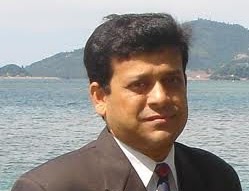
Ujjwal Maulik is an Indian computer scientist and a professor. He is the former chair of the Department of Computer Science and Engineering at Jadavpur University, Kolkata, West Bengal, India. He also held the position of the principal-in-charge and the head of the Department of Computer Science and Engineering at Kalyani Government Engineering College.
In the domain of physics and probability, the filters, random fields, and maximum entropy (FRAME) model is a Markov random field model of stationary spatial processes, in which the energy function is the sum of translation-invariant potential functions that are one-dimensional non-linear transformations of linear filter responses. The FRAME model was originally developed by Song-Chun Zhu, Ying Nian Wu, and David Mumford for modeling stochastic texture patterns, such as grasses, tree leaves, brick walls, water waves, etc. This model is the maximum entropy distribution that reproduces the observed marginal histograms of responses from a bank of filters, where for each filter tuned to a specific scale and orientation, the marginal histogram is pooled over all the pixels in the image domain. The FRAME model is also proved to be equivalent to the micro-canonical ensemble, which was named the Julesz ensemble. Gibbs sampler is adopted to synthesize texture images by drawing samples from the FRAME model.
Jiaya Jia is a tenured professor of the Department of Computer Science and Engineering at The Chinese University of Hong Kong (CUHK). He is an IEEE Fellow, the associate editor-in-chief of one of IEEE’s flagship and premier journals- Transactions on Pattern Analysis and Machine Intelligence (TPAMI), as well as on the editorial board of International Journal of Computer Vision (IJCV).

Mário A. T. Figueiredo is a Portuguese engineer, academic, and researcher. He is an IST Distinguished Professor and holds the Feedzai chair of machine learning at IST, University of Lisbon.
References
- 1 2 Daugman, J. (2004). "How Iris Recognition Works". IEEE Transactions on Circuits and Systems for Video Technology. 14: 21–30. doi:10.1109/TCSVT.2003.818350.
- ↑ "Biometric personal identification system based on iris analysis" . Retrieved 6 December 2010.
- ↑ John Daugman's publications indexed by the Scopus bibliographic database. (subscription required)
- ↑ Daugman, J.G. (1993). "High confidence visual recognition of persons by a test of statistical independence". IEEE Transactions on Pattern Analysis and Machine Intelligence. 15 (11): 1148–1161. CiteSeerX 10.1.1.504.8147 . doi:10.1109/34.244676.
- ↑ Daugman, John G. (1985). "Uncertainty relation for resolution in space, spatial frequency, and orientation optimized by two-dimensional visual cortical filters". Journal of the Optical Society of America A. 2 (7): 1160–9. Bibcode:1985JOSAA...2.1160D. doi:10.1364/JOSAA.2.001160. PMID 4020513.
- ↑ "John Daugman's webpage". University of Cambridge. Archived from the original on 29 April 2015.
- ↑ "Short biographical sketch, John Daugman". University of Cambridge. Archived from the original on 24 March 2014.
- ↑ "Plenary Speakers" . Retrieved 16 February 2011.
- ↑ "Research Excellence Framework". Research Excellence Framework. Iris Recognition. Retrieved 25 April 2015.
- ↑ Daugman, John (2016). "Information Theory and the IrisCode". IEEE Transactions on Information Forensics and Security. 11 (2): 400–409. doi:10.1109/TIFS.2015.2500196. S2CID 16326311.
- ↑ John Daugman (2004). "How Iris Recognition Works". CiteSeerX 10.1.1.6.2684 .
- ↑ "American Scientist Online" . Retrieved 16 February 2011.